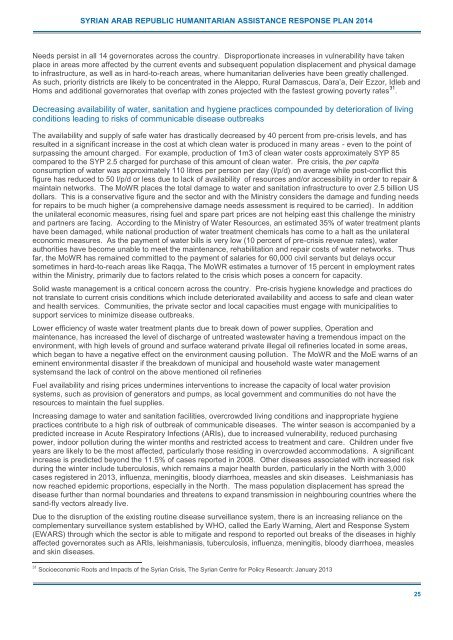2014 Syrian Arab Republic Humanitarian Assistance Response Plan (SHARP)
- No tags were found...
You also want an ePaper? Increase the reach of your titles
YUMPU automatically turns print PDFs into web optimized ePapers that Google loves.
SYRIAN ARAB REPUBLIC HUMANITARIAN ASSISTANCE RESPONSE PLAN <strong>2014</strong><br />
Needs persist in all 14 governorates across the country. Disproportionate increases in vulnerability have taken<br />
place in areas more affected by the current events and subsequent population displacement and physical damage<br />
to infrastructure, as well as in hard-to-reach areas, where humanitarian deliveries have been greatly challenged.<br />
As such, priority districts are likely to be concentrated in the Aleppo, Rural Damascus, Dara‟a, Deir Ezzor, Idleb and<br />
Homs and additional governorates that overlap with zones projected with the fastest growing poverty rates 31 .<br />
Decreasing availability of water, sanitation and hygiene practices compounded by deterioration of living<br />
conditions leading to risks of communicable disease outbreaks<br />
The availability and supply of safe water has drastically decreased by 40 percent from pre-crisis levels, and has<br />
resulted in a significant increase in the cost at which clean water is produced in many areas - even to the point of<br />
surpassing the amount charged. For example, production of 1m3 of clean water costs approximately SYP 85<br />
compared to the SYP 2.5 charged for purchase of this amount of clean water. Pre crisis, the per capita<br />
consumption of water was approximately 110 litres per person per day (l/p/d) on average while post-conflict this<br />
figure has reduced to 50 l/p/d or less due to lack of availability of resources and/or accessibility in order to repair &<br />
maintain networks. The MoWR places the total damage to water and sanitation infrastructure to over 2.5 billion US<br />
dollars. This is a conservative figure and the sector and with the Ministry considers the damage and funding needs<br />
for repairs to be much higher (a comprehensive damage needs assessment is required to be carried). In addition<br />
the unilateral economic measures, rising fuel and spare part prices are not helping east this challenge the ministry<br />
and partners are facing. According to the Ministry of Water Resources, an estimated 35% of water treatment plants<br />
have been damaged, while national production of water treatment chemicals has come to a halt as the unilateral<br />
economic measures. As the payment of water bills is very low (10 percent of pre-crisis revenue rates), water<br />
authorities have become unable to meet the maintenance, rehabilitation and repair costs of water networks. Thus<br />
far, the MoWR has remained committed to the payment of salaries for 60,000 civil servants but delays occur<br />
sometimes in hard-to-reach areas like Raqqa, The MoWR estimates a turnover of 15 percent in employment rates<br />
within the Ministry, primarily due to factors related to the crisis which poses a concern for capacity.<br />
Solid waste management is a critical concern across the country. Pre-crisis hygiene knowledge and practices do<br />
not translate to current crisis conditions which include deteriorated availability and access to safe and clean water<br />
and health services. Communities, the private sector and local capacities must engage with municipalities to<br />
support services to minimize disease outbreaks.<br />
Lower efficiency of waste water treatment plants due to break down of power supplies, Operation and<br />
maintenance, has increased the level of discharge of untreated wastewater having a tremendous impact on the<br />
environment, with high levels of ground and surface waterand private illegal oil refineries located in some areas,<br />
which began to have a negative effect on the environment causing pollution. The MoWR and the MoE warns of an<br />
eminent environmental disaster if the breakdown of municipal and household waste water management<br />
systemsand the lack of control on the above mentioned oil refineries<br />
Fuel availability and rising prices undermines interventions to increase the capacity of local water provision<br />
systems, such as provision of generators and pumps, as local government and communities do not have the<br />
resources to maintain the fuel supplies.<br />
Increasing damage to water and sanitation facilities, overcrowded living conditions and inappropriate hygiene<br />
practices contribute to a high risk of outbreak of communicable diseases. The winter season is accompanied by a<br />
predicted increase in Acute Respiratory Infections (ARIs), due to increased vulnerability, reduced purchasing<br />
power, indoor pollution during the winter months and restricted access to treatment and care. Children under five<br />
years are likely to be the most affected, particularly those residing in overcrowded accommodations. A significant<br />
increase is predicted beyond the 11.5% of cases reported in 2008. Other diseases associated with increased risk<br />
during the winter include tuberculosis, which remains a major health burden, particularly in the North with 3,000<br />
cases registered in 2013, influenza, meningitis, bloody diarrhoea, measles and skin diseases. Leishmaniasis has<br />
now reached epidemic proportions, especially in the North. The mass population displacement has spread the<br />
disease further than normal boundaries and threatens to expand transmission in neighbouring countries where the<br />
sand-fly vectors already live.<br />
Due to the disruption of the existing routine disease surveillance system, there is an increasing reliance on the<br />
complementary surveillance system established by WHO, called the Early Warning, Alert and <strong>Response</strong> System<br />
(EWARS) through which the sector is able to mitigate and respond to reported out breaks of the diseases in highly<br />
affected governorates such as ARIs, leishmaniasis, tuberculosis, influenza, meningitis, bloody diarrhoea, measles<br />
and skin diseases.<br />
31 Socioeconomic Roots and Impacts of the <strong>Syrian</strong> Crisis, The <strong>Syrian</strong> Centre for Policy Research: January 2013<br />
25



